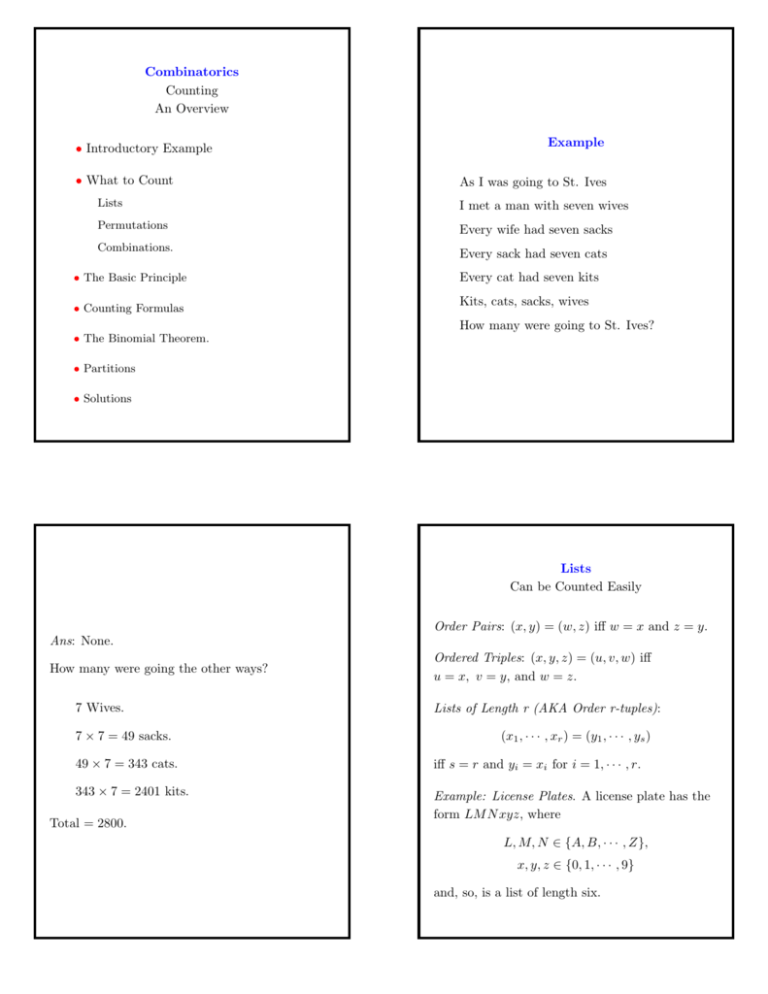Combinatorics Counting An Overview • Introductory Example • What
advertisement

Combinatorics
Counting
An Overview
• Introductory Example
• What to Count
Example
As I was going to St. Ives
Lists
I met a man with seven wives
Permutations
Every wife had seven sacks
Combinations.
Every sack had seven cats
• The Basic Principle
• Counting Formulas
Every cat had seven kits
Kits, cats, sacks, wives
How many were going to St. Ives?
• The Binomial Theorem.
• Partitions
• Solutions
Lists
Can be Counted Easily
Order Pairs: (x, y) = (w, z) iff w = x and z = y.
Ans: None.
How many were going the other ways?
7 Wives.
7 × 7 = 49 sacks.
Ordered Triples: (x, y, z) = (u, v, w) iff
u = x, v = y, and w = z.
Lists of Length r (AKA Order r-tuples):
(x1 , · · · , xr ) = (y1 , · · · , ys )
49 × 7 = 343 cats.
iff s = r and yi = xi for i = 1, · · · , r.
343 × 7 = 2401 kits.
Example: License Plates. A license plate has the
form LM N xyz, where
Total = 2800.
L, M, N ∈ {A, B, · · · , Z},
x, y, z ∈ {0, 1, · · · , 9}
and, so, is a list of length six.
Basic Principle of Combinatorics
The Multiplication Principle
Permutations
For Two: If there are m choices for x and then n
choices for y, then there are m × n choices for
(x, y).
A permutation of length r is a list
(x1 , · · · , xr ) with distinct components (no
repetition); that is, xi 6= xj when i 6= j.
For Several: If there are ni choices for xi ,
i = 1, · · · , r, then there are
Examples. (1, 2, 3) is a permutation of three
elements; (1, 2, 1) is a list, but not a permutation
n1 × n 2 × · · · × n r
choices for (x1 , · · · , xr ).
Counting Formulas. From n objects,
nr = n × · · · × n (r factors)
3
Example. There are 7 = 7 × 7 × 7 = 343 choices
for (wife, sack, cat).
Example. There are
263 × 103 = 17, 576, 000
license plates. Of these
26 × 25 × 24 × 10 × 9 × 8 = 11, 232, 000
have distinct letters and digits (no repetition).
lists of length r and
(n)r := n × (n − 1) × · · · × (n − r + 1)
permutations of length r may be formed.
Examples: There are 103 = 1000 three digit
numbers of which (10)3 = 10 × 9 × 8 = 720 list
distinct digits.
Some Notation. Recall
(n)r = n × (n − 1) × · · · × (n − r + 1)
positive integers n and r.
Factorials: When r = n, write
n! = (n)n = n × (n − 1) × · · · × 2 × 1.
Conventions: (n)0 = 1 and 0! = 1.
Notes a). The book only considers r = n.
b). (n)r = 0 if r > n.
c). If r < n, then
n! = (n)r (n − r)!
Examples
Example. A group of 9 people may choose officers
(P,VP,S,T) in (9)4 = 3024 ways.
Example. 7 books may be arranged in 7! = 5040
ways.
If there are 4 math books and 3 science books,
then there are
2 × 4! × 3! = 288
arrangements in which the math books are
together and the science books are together.
Combinations
A combination of size r is a set {x1 , · · · , xr }
of r distinct elements. Two combinations are
equal if they have the same elements, possibly
written in different orders.
Example. {1, 2, 3} = {3, 2, 1}, but
(1, 2, 3) 6= (3, 2, 1).
Example. How many committees of size 4 may be
chosen from 9 people? Choose officers in two
steps:
Choose a committee in ?? ways.
Choose officers from the committee in 4!
ways.
From the Basic Principle
(9)4 = 4!×??.
So,
?? =
(9)4
= 126.
4!
Combinations Formula
From n ≥ 1 objects,
1
n
= (n)r
r
r!
combinations of size r ≤ n may be formed.
Example.
9
1
= (9)4 = 126.
4!
4
Proof: Replace 9 and 4 by n and r in the
example.
Example: Bridge. A bridge hand is a combination
of n = 13 cards drawn from a standard deck of
N = 52. There are
52
= 635, 013, 559, 600
13
such hands.
Binomial Coefficients
Alternatively:
n
n!
=
.
r
r!(n − r)!
The Binomial Theorem: For all
−∞ < x, y < ∞,
n X
n r n−r
n
(x + y) =
x y
.
r
r=0
Example. When n = 3,
(x + y)3 = x3 + 3x2 y + 3xy 2 + y 3 .
Proof. If
(x + y)n = (x + y) × · · · × (x + y)
is expanded, then xr y n−r will appear as often as
x can be chosen from r of the n factors; i.e., in
n
r
ways.
Binomial Identities
Recall:
n X
n r n−r
x y
.
(x + y) =
r
r=0
n
Examples -a). Setting x = y = 1,
n X
n
= 2n .
r
r=0
b). Letting x = −1 and y = 1,
n X
n
(−1)r = 0
r
r=0
for n ≥ 1.
Partitions
Defintions
Partitions
AKA Divisions
An Example
Let Z be a set with n elements. If r ≥ 2 is an
integer,then an ordered partition of Z into r
subsets is a list
Q: How many distinct arrangements can be
formed from the letters
(Z1 , · · · , Zr )
MISSISSIPPI?
A: There are 11 letters which may be arranged in
11! = 39, 916, 800
where Z1 , · · · , Zr are mutually exclusive subsets
of Z whose union is Z; that is,
(∗)
ways, but this leads to double counting. If the 4
“S”s are permuted, then nothing is changed.
Similarly, for the 4 “I”s and 2 “P”s. So, (*) the
each configuration of letters
4! × 4! × 2! = 1, 152
Zi ∩ Zj = ∅ if i 6= j
and
Z1 ∪ · · · ∪ Zr = Z.
Let
ni = #Zi ,
the number of elements in Zi . Then
times and the answer is
11!
= 34, 650.
4! × 4! × 2!
n1 , · · · , n r ≥ 0
and
n1 + · · · + nr = n.
The Partitions Formula
Let n, r, and n1 , · · · , nr be integers for which
Example. In the “MISSISSIPPI” Example, 11
positions,
n, r ≥ 1,
n1 , · · · , nr ≥ 0,
Z = {1, 2, · · · , 11}
n1 + · · · + nr = n.
were partitioned into four groups of sizes
n1 = 4 “I”s
n2 = 1 “M”s
n3 = 2 “P”s
n4 = 4 “S”s
Example. In a bridge game, a deck of 52 cards is
partitioned into four hands of size 13 each, one for
each of South, West, North, and East.
If Z is a set of n elements, then there are
n
n!
:=
n1 ! × · · · × n r !
n1 , · · · , n r
ways to partition Z into r subsets (Z1 , · · · , Zr )
for which #Zi = ni for i = 1, · · · , r.
Example.
11
= 34, 650.
4, 1, 2, 4
Def. Called multinomial coefficients
The Number of Solutions
Continued
The Number of Solutions
If n and r are positive integers, how many integer
solutions to the equations
n1 , · · · , n r ≥ 0
n1 + · · · + n r = n
Second Warm Up Example. Suppose n = 8 and
r = 4. Represent solutions by o and ” + ” by |.
For example,
ooo|oo||ooo
means
n1 = 3,
are there?
n2 = 2,
First Warm Up Example. How many
arrangements from a A’s and b B’s–for example,
ABAAB)? There are
a+b
a+b
=
b
a
such, since an arrangement is determined by the a
places occupied by A.
n3 = 0,
n4 = 3.
Note: Only r − 1 = 3 |’s are needed.
There are as many solutions as there are ways to
arrange o and |. By the last example, there are
8+3
11
=
= 165
3
3
solutions.
A General Formula
If n and r are positive integers, then there are
n+r−1
n+r−1
=
r−1
n
• Lists, permuatations, and combinations.
• The Basic Principle
integer solutios to
n1 , · · · , n r ≥ 0
n1 + · · · + nr = n.
If n ≥ r, then there are
n−1
r−1
• Counting Formulas
Lists nr
Permuations (n)r
Combinations nr
Partitions
solutions with
ni ≥ 1
for i = 1, · · · , r.
Combinatorics
Summary
Solutions
n
n1 ,··· ,nr
n+r−1
r−1











